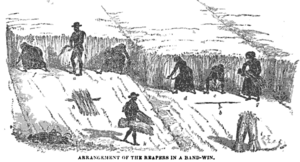Bandwin facts for kids
A bandwin was a special team of farm workers in the Scottish Lowlands a long time ago, before big changes in farming. Their main job was to harvest crops like grain. The word "bandwin" was first used in 1642.
These teams usually had a few people: reapers who cut the crops, and a "bandster" who gathered and tied them into bundles called sheaves. What was interesting about bandwins was that the work done by women was almost as important and valued as the work done by men.
What Was a Bandwin?
The word "bandwin" first appeared in official records from Aberdeenshire, Scotland, in 1642. It might have come from the "bands" of stalks used to tie the grain bundles. Or, it could be because the group itself was a "band" or team of workers.
How a Bandwin Worked
Most of the people in a bandwin were women, often from the Scottish Highlands. A typical bandwin had seven members:
- Six shearers: These workers used a curved tool called a sickle to cut the grain.
- One bandster: This person followed the shearers, gathering the cut grain and tying it into sheaves.
The shearers were split into two teams. Each team worked on two long strips of land called a runrig. The bandster was usually a man. The two shearing teams ideally had two women and one man each.
The man in each team would cut the longest and strongest stalks in the middle of their section. The woman on the right side had the hardest job because she had to reach across to the next strip of land. To make it fair, the two women in a team would switch places regularly. One bandster could tie up the grain for two teams of shearers. Together, six shearers could cut about two acres of crops in a single day!
Fair Pay in the Bandwin
It was quite unusual for women's work to be valued so highly back then. In the mid-1700s, female reapers earned 5 pence a day. Male reapers earned a bit more, 6 pence a day, and the bandster earned the most, 7 pence a day. This shows that women played a very important role in getting the harvest done.



